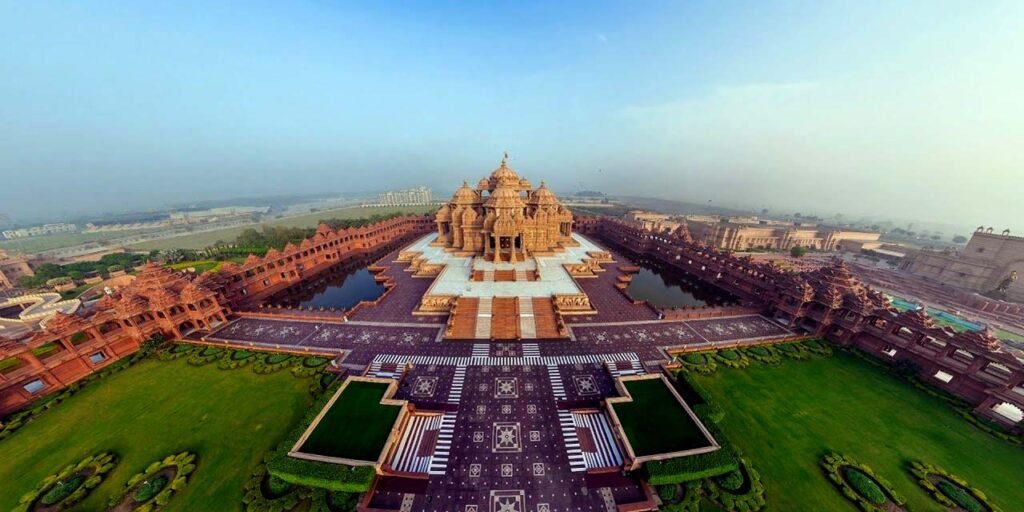Akshar Dham Temple, commonly referred to as Swaminarayan Akshardham Temple, is one of the most magnificent spiritual landmarks in India, epitomizing divine tranquility, traditional Hindu architecture, and cultural richness. Located in the heart of New Delhi, this temple is a sacred abode for millions and attracts devotees and tourists from across the globe, due to its spiritual significance, awe-inspiring architecture, and vibrant cultural activities.
Overview of Akshar Dham Temple
Akshar Dham Temple, or Swaminarayan Akshardham, is not only a place of worship but also a spiritual and cultural experience. The temple stands on the banks of the Yamuna River and provides visitors a serene environment for devotion, reflection, and cultural learning. This spiritual campus was designed with the intent to be a timeless abode of God, radiating eternal values and fostering an atmosphere of peace and devotion. Its grandeur and spiritual ethos draw in pilgrims, history enthusiasts, architectural aficionados, and tourists seeking solace and inspiration.
History of Akshar Dham Temple
Conceived as a tribute to Bhagwan Swaminarayan, the vision for Akshardham was first articulated in 1968 by Yogiji Maharaj, the fourth spiritual leader of BAPS (Bochasanwasi Shri Akshar Purushottam Swaminarayan Sanstha). The construction began in 2000 under the guidance of Pramukh Swami Maharaj, Yogiji Maharaj’s successor. The Delhi and Uttar Pradesh governments allocated over 90 acres for its development. More than 8,000 volunteers from all over the world contributed to building the temple, which officially opened its doors on November 6, 2005, celebrated by prominent leaders like the Prime Minister of India. Legends and stories connected to Swaminarayan—regarded as an incarnation of God and a spiritual luminary—permeate the temple, sustaining its aura of sanctity and historical reverence.
Architectural Significance
Akshar Dham Temple stands as a marvel of traditional Indian architecture, built according to ancient shilpa shastras (architectural guidelines). The mandir is crafted from pink Rajasthani sandstone and Italian Carrara marble, constructed entirely without ferrous metals—no steel or concrete supports. The temple rises 143 feet, stretches 316 feet wide, and is 356 feet long. Its interior showcases 234 ornately carved pillars, 9 majestic domes, and more than 20,000 statues depicting deities, saints, sages, dancers, and motifs from Hindu mythology.
Notable features include:
- Gajendra Pith: A base platform with 148 life-sized elephants.
- Intricate murals and carvings throughout pillars, ceilings, and domes.
- Central dome and several smaller domes embodying spiritual symbolism.
Materials and motifs symbolize purity, divinity, and Indian lore, making architectural elements not just visually stunning but spiritually significant.
Deities and Religious Importance

The principal deity enshrined in Akshar Dham is Bhagwan Swaminarayan, depicted in a 3.4-meter high murti beneath the central dome. Surrounding him are murtis of the faith’s lineage of gurus and other prominent figures. The temple also honors Rama-Sita, Radha-Krishna, Shiva-Parvati, and Lakshmi-Narayana, reflecting the inclusive nature of Hindu worship.
Central rituals and traditions include:
- Aarti ceremonies (morning and evening).
- Abhishek rituals, where devotees pour sacred water over deities in prayer.
- Daily prayers, bhajans, and spiritual discourses.
Major Festivals and Celebrations
Celebrations at Akshar Dham Temple mirror the vibrancy of Hindu tradition. Key festivals observed include:
- Diwali (Festival of Lights): The temple is lit with 10,000 lamps, symbolizing enlightenment and the dispelling of darkness.
- Hindu New Year: Processions, music, and special darshan.
- Janmashtami, Ram Navami, Shivratri, and Guru Purnima: Marked by special rituals, decorations, and mass participation.
Cultural performances, devotional music, and spiritual lectures accompany these festivals, creating a communal atmosphere of faith and joy.
Spiritual and Cultural Activities
Akshar Dham Temple conducts daily aartis, Vedic chanting sessions, bhajans, and meditation programs that nurture spiritual growth. The temple trust organizes diverse charitable activities—health camps, education initiatives, and disaster relief—which emphasize compassion beyond ritual. Regular meditation and yoga sessions are held to facilitate personal well-being and collective harmony.
How to Reach Akshar Dham Temple
Located on NH 24, Pramukh Swami Maharaj Marg in New Delhi, Akshar Dham offers easy access:
- Nearest Metro: Akshardham Metro Station (Blue Line), a 5-minute walk from the temple.
- Railway Stations: Hazrat Nizamuddin (6 km), New Delhi (11 km), Old Delhi (10 km).
- Airport: Indira Gandhi International Airport (21 km).
- Bus routes and taxis: Delhi Transport Corporation operates several buses. Auto-rickshaws and taxis are popular local options.
Best time to visit: October to March, when the weather is pleasant and major festivities occur.
Visitor Information
Akshar Dham Temple is open from 10:00 AM to 6:30 PM, except Mondays. Darshan is available till 8:00 PM, with aarti at 10:30 AM and 6:00 PM. Entry to the temple and darshan is free, but exhibitions and special shows have nominal ticket charges for adults, seniors, and children.
Visitors must adhere to a modest dress code: upper wear must cover shoulders, chest, and arms; lower wear must be below the knees. Photography is restricted inside—photo prints are available at the Book and Gift Center. Ample parking and cloakroom facilities are provided, along with vegetarian food at the Premvati Food Court. Accommodation options are available nearby in New Delhi, catering to various budgets.
Significance of the Name “Akshar Dham”
The term “Akshar” translates to “eternal,” and “Dham” means “divine abode”. The name signifies an immortal space for devotion, purity, and peace, where God’s presence is believed to be everlasting. Spiritually, Akshar Dham conveys the idea of transcendence and perpetual sanctity—echoing its architectural beauty and timeless spiritual teachings.
Conclusion
Akshar Dham Temple embodies the ideals of peace, devotion, and eternal faith, making it a must-visit destination for every spiritual seeker and tourist. With its harmonious blend of spirituality, history, art, and architecture, the temple imparts a profound message: human life attains meaning through devotion and service, guiding souls from darkness to light. Visiting Akshar Dham rejuvenates the mind, inspires the heart, and strengthens one’s eternal faith—fulfilling the promise of the temple’s name as an everlasting abode of divinity.
FAQ
1. Where is Akshar Dham Temple located?
Akshar Dham Temple is located in [insert city/state name, e.g., Vrindavan, Uttar Pradesh]. It is easily accessible by road and rail from major nearby cities.
2. What is the significance of Akshar Dham Temple?
The temple is dedicated to promoting eternal peace, devotion, and spiritual awakening. The word “Akshar” means eternal, and “Dham” means divine abode, symbolizing everlasting faith in God.
3. Which deity is worshipped at Akshar Dham Temple?
The main deity of Akshar Dham Temple is Lord Vishnu (or Lord Krishna, depending on the temple’s tradition). Other deities like Goddess Lakshmi and Lord Hanuman are also worshipped here.
4. What are the visiting hours of Akshar Dham Temple?
The temple usually opens from 5:00 AM to 12:00 PM and again from 4:00 PM to 9:00 PM. However, timings may vary on special occasions and festivals.
5. Is there any entry fee to visit Akshar Dham Temple?
No, entry to Akshar Dham Temple is completely free. Devotees are welcome to offer donations voluntarily.
6. What are the main festivals celebrated at Akshar Dham Temple?
Major festivals include Janmashtami, Diwali, Ram Navami, and Akshaya Tritiya. These occasions attract thousands of devotees from across the country.
7. How can I reach Akshar Dham Temple?
The temple is well-connected by road, rail, and air. The nearest railway station and airport depend on the city where the temple is located. Local taxis and auto-rickshaws are easily available.
8. Are there accommodation facilities near the temple?
Yes, several guest houses, dharamshalas, and hotels are available near the temple for devotees and tourists.
9. What is the best time to visit Akshar Dham Temple?
The best time to visit is during winter months (October to March) and during major festivals when the temple is beautifully decorated.
10. Is photography allowed inside Akshar Dham Temple?
Photography is usually allowed in the outer premises but may be restricted inside the sanctum sanctorum. Visitors should follow temple guidelines.
Krishna Mishra writes for Insights of Hinduism, where he shares heartfelt thoughts on festivals, traditions, and the timeless wisdom of Sanatan Dharma. His aim is to keep the essence of Hindu culture alive in a way that feels simple, authentic, and relatable to everyone.


